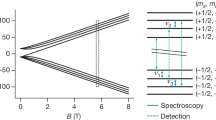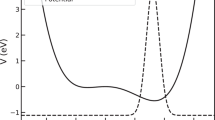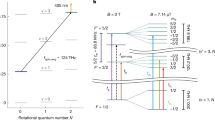Abstract
Quantum electrodynamics has been tested to accuracies below the parts-per-trillion level in light-mass systems. However, tests in heavy-mass systems with a large nuclear charge have not yet reached similar accuracy. Here we report the hyperfine-structure splitting in the 1s ground state of radioactive hydrogen-like 208Bi82+. We produced the isotope in a nuclear reaction and injected the beam into a storage ring to perform laser spectroscopy on samples of 105 ions of Bi82+ that have only a single remaining electron, which experiences extreme magnetic-field strengths. Our result for the hyperfine splitting is in excellent agreement with the most accurate prediction based on a combination of quantum electrodynamics calculations with an empirical treatment of the hyperfine-structure anomaly ratio extracted from laser spectroscopy on neutral atoms of 209Bi and 208Bi. This achievement paves the way for the most stringent test of quantum electrodynamics in strong magnetic fields and demonstrates the feasibility of laser spectroscopy on other exotic ions with low production yields.
This is a preview of subscription content, access via your institution
Access options
Access Nature and 54 other Nature Portfolio journals
Get Nature+, our best-value online-access subscription
$32.99 / 30 days
cancel any time
Subscribe to this journal
Receive 12 print issues and online access
$259.00 per year
only $21.58 per issue
Buy this article
- Purchase on SpringerLink
- Instant access to full article PDF
Prices may be subject to local taxes which are calculated during checkout





Similar content being viewed by others
Data availability
The datasets generated during the beamtime and analysed for the current study are subject to further analysis. They are available from the corresponding authors on reasonable request and will be made publicly available and linked to 10.26083/tuprints-00026367 at a later stage.
References
van Dyck, R. S., Schwinberg, P. B. & Dehmelt, H. G. New high-precision comparison of electron and positron g factors. Phys. Rev. Lett. 59, 26–29 (1987).
Hanneke, D., Fogwell, S. & Gabrielse, G. New measurement of the electron magnetic moment and the fine structure constant. Phys. Rev. Lett. 100, 120801 (2008).
Fan, X., Myers, T. G., Sukra, B. A. D. & Gabrielse, G. Measurement of the electron magnetic moment. Phys. Rev. Lett. 130, 071801 (2023).
Heisenberg, W. & Euler, H. Folgerungen aus der Diracschen Theorie des Positrons. Z. Phys. 98, 714–732 (1936).
Schwinger, J. On gauge invariance and vacuum polarization. Phys. Rev. 82, 664–679 (1951).
Fedotov, A. et al. Advances in QED with intense background fields. Phys. Rep. 1010, 1–138 (2023).
Beiersdorfer, P., Chen, H., Thorn, D. B. & Träbert, E. Measurement of the two-loop Lamb shift in lithium-like U89+. Phys. Rev. Lett. 95, 233003 (2005).
Loetzsch, R. et al. Testing quantum electrodynamics in extreme fields using helium-like uranium. Nature 625, 673–678 (2024).
Safronova, M. S. et al. Search for new physics with atoms and molecules. Rev. Mod. Phys. 90, 025008 (2018).
Abi, B. et al. Measurement of the positive muon anomalous magnetic moment to 0.46 ppm. Phys. Rev. Lett. 126, 141801 (2021).
Aguillard, D. P. et al. Measurement of the positive muon anomalous magnetic moment to 0.20 ppm. Phys. Rev. Lett. 131, 161802 (2023).
King, S. A. et al. An optical atomic clock based on a highly charged ion. Nature 611, 43–47 (2022).
Kozlov, M. G., Safronova, M. S., Crespo López-Urrutia, J. R. & Schmidt, P. O. Highly charged ions: optical clocks and applications in fundamental physics. Rev. Mod. Phys. 90, 045005 (2018).
Shabaev, V. M. et al. QED effects in heavy few-electron ions. Int. J. Mass Spec. 251, 109–118 (2006).
Gumberidze, A. et al. Quantum electrodynamics in strong electric fields: the ground-state Lamb shift in hydrogen-like uranium. Phys. Rev. Lett. 94, 223001 (2005).
Morgner, J. et al. Stringent test of QED with hydrogen-like tin. Nature 622, 53–57 (2023).
Klaft, I. et al. Precision laser spectroscopy of the ground state hyperfine splitting of hydrogen-like 209Bi82+. Phys. Rev. Lett. 73, 2425–2427 (1994).
Seelig, P. et al. Ground state hyperfine splitting of hydrogen-like 207Pb81+ by laser excitation of a bunched ion beam in the GSI experimental storage ring. Phys. Rev. Lett. 81, 4824–4827 (1998).
Ullmann, J. et al. An improved value for the hyperfine splitting of hydrogen-like 209Bi82+. J. Phys. B 48, 144022 (2015).
Beier, T. The gj factor of a bound electron and the hyperfine structure splitting in hydrogen-like ions. Phys. Rep. 339, 79–213 (2000).
Lochmann, M. et al. Observation of the hyperfine transition in lithium-like bismuth 209Bi80+: towards a test of QED in strong magnetic fields. Phys. Rev. A 90, 030501 (2014).
Crespo López-Urrutia, J. R. et al. Nuclear magnetization distribution radii determined by hyperfine transitions in the 1s level of H-like ions 185Re74+ and 187Re74+. Phys. Rev. A 57, 879–887 (1998).
Crespo López-Urrutia, J. R., Beiersdorfer, P., Savin, D. W. & Widmann, K. Direct observation of the spontaneous emission of the hyperfine transition F = 4 to F = 3 in ground state hydrogen-like 165Ho66+ in an electron beam ion trap. Phys. Rev. Lett. 77, 826–829 (1996).
Beiersdorfer, P. et al. Hyperfine structure of hydrogen-like thallium isotopes. Phys. Rev. A 64, 032506 (2001).
Bohr, A. & Weisskopf, V. F. The influence of nuclear structure on the hyperfine structure of heavy elements. Phys. Rev. 77, 94–98 (1950).
Zherebtsov, O. M. & Shabaev, V. M. Higher order interelectronic-interaction corrections to the ground-state hyperfine splitting in lithium-like ions. Can. J. Phys. 78, 701–709 (2000).
Sen’kov, R. A. & Dmitriev, V. F. Nuclear magnetization distribution and hyperfine splitting in Bi82+ ion. Nucl. Phys. A 706, 351–364 (2002).
Schmidt, S. et al. The nuclear magnetic moment of 208Bi and its relevance for a test of bound-state strong-field QED. Phys. Lett. B 779, 324–330 (2018).
Hellwig, H. et al. Measurement of the unperturbed hydrogen hyperfine transition frequency. IEEE Transact. Instrum. Meas. 19, 200–209 (1970).
Skripnikov, L. V. Nuclear magnetization distribution effect in molecules: Ra+ and RaF hyperfine structure. J. Chem. Phys. 153, 114114 (2020).
Skripnikov, L. V. & Barzakh, A. E. Reexamination of nuclear magnetic dipole and electric quadrupole moments of polonium isotopes. Phys. Rev. C 109, 024315 (2024).
Roberts, B. M., Ranclaud, P. G. & Ginges, J. S. M. Bohr-Weisskopf effect: from hydrogen-like-ion experiments to heavy-atom calculations of the hyperfine structure. Phys. Rev. A 105, 052802 (2022).
Ullmann, J. et al. High precision hyperfine measurements in bismuth challenge bound-state strong-field QED. Nat. Commun. 8, 15484 (2017).
Tiedau, J. et al. Laser excitation of the Th-229 nucleus. Phys. Rev. Lett. 132, 182501 (2024).
Shabaev, V. M. et al. Ground-state g factor of highly charged 229Th ions: an access to the M1 transition probability between the isomeric and ground nuclear states. Phys. Rev. Lett. 128, 043001 (2022).
Franzke, B. The heavy ion storage and cooler ring project ESR at GSI. Nucl. Instr. Meth. Phys. Res. B 24-25, 18–25 (1987).
Brandau, C. et al. Isotope shifts in dielectronic recombination: from stable to in-flight-produced nuclei. J. Phys. Conf. Ser. 194, 012023 (2009).
Nolden, F. et al. A fast and sensitive resonant Schottky pick-up for heavy ion storage rings. Nucl. Instr. Meth. Phys. Res. A 659, 69–77 (2011).
Litvinov, Y. A. et al. Nuclear physics experiments with ion storage rings. Nucl. Instr. Meth. Phys. Res. B 317, 603–616 (2013).
Skripnikov, L. V. et al. New nuclear magnetic moment of 209Bi: resolving the bismuth hyperfine puzzle. Phys. Rev. Lett. 120, 093001 (2018).
Antušek, A. et al. Nuclear magnetic dipole moment of 209Bi from NMR experiments. Phys. Rev. A 98, 052509 (2018).
Shabaev, V. M., Artemyev, A. N., Yerokhin, V. A., Zherebtsov, O. M. & Soff, G. Towards a test of QED in investigations of the hyperfine splitting in heavy ions. Phys. Rev. Lett. 86, 3959–3962 (2001).
Miyagi, T. et al. Impact of two-body currents on magnetic dipole moments of nuclei. Phys. Rev. Lett. 132, 232503 (2024).
Kraemer, S. et al. Observation of the radiative decay of the 229Th nuclear clock isomer. Nature 617, 706–710 (2023).
Beeks, K. et al. The thorium-229 low-energy isomer and the nuclear clock. Nat. Rev. Phys. 3, 238–248 (2021).
Campbell, C. J. et al. Single-ion nuclear clock for metrology at the 19th decimal place. Phys. Rev. Lett. 108, 120802 (2012).
Horst, M. Laser Spectroscopy of 208Bi82+ and Commissioning of the HITRAP Cooling Trap. Phd thesis, TU Darmstadt (2023).
Heyde, K. The Nuclear Shell Model (Springer, 1994).
Fella, V. et al. Magnetic moment of 207Pb and the hyperfine splitting of 207Pb81+. Phys. Rev. Res. 2, 013368 (2020).
Bosch, F., Litvinov, Y. A. & Stöhlker, T. Nuclear physics with unstable ions at storage rings. Progr. Part. Nucl. Phys. 73, 84–140 (2013).
Poth, H. Electron cooling—theory, experiment, application. Phys. Rep. 196, 135–297 (1990).
Sánchez, R. et al. Laser spectroscopy measurement of the 2s-hyperfine splitting in lithium-like bismuth. J. Phys. B 50, 085004 (2017).
Franzke, B. in CAS—CERN Accelerator School: Fourth Advanced Accelerator Physics Course (ed. Turner, S.) 100–119 (CERN, 1992).
Volotka, A. V. et al. Test of many-electron QED effects in the hyperfine splitting of heavy high-Z ions. Phys. Rev. Lett. 108, 073001 (2012).
Micke, P. et al. Coherent laser spectroscopy of highly charged ions using quantum logic. Nature 578, 60–65 (2020).
Acknowledgements
The results presented here are based on experiment E128, which was performed at the ESR at the GSI Helmholtzzentrum fuer Schwerionenforschung, Darmstadt (Germany), in the frame of FAIR Phase-0 and the SPARC Collaboration. W.N. thanks L. Skripnikov for valuable discussions. We acknowledge financial support from the German Ministry for Education and Research under grants 05P21RDFA1 (M.H., W.N. and S.R), 05P21PMFA1 (V.H., K.U. and C.W.) and 05P21RDFN1 (K.M. and W.N.), from the State of Hesse within the Research Cluster ELEMENTS Project ID 500/10.006 (C.B., J.G., Y.A.L. and T.S.) and from the Canadian Natural Sciences and Engineering Research Council (NSERC) via grant SAPIN-2019-00030 (G.L.). M.H., P.I., P.M. and S.R. acknowledge support from HGS-HiRe.
Author information
Authors and Affiliations
Contributions
The experiment was planned by W.N., R.S., C.B. and T.S. The laser system was set up and maintained by R.S. Data acquisition was prepared by C.B., K.M. and U.S. High-voltage measurements were performed by J.M., S.P., J.R. and K.K. The detection systems were prepared by C.B., V.H., W.N., T.R. and C.W. Storage-ring optimization and operation was performed by R.H., S.L., B.L., J.R. and M.S. The Schottky measurement system was set up and operated by C.B., R.J.C. and S.S. The experiment was prepared and performed by Z.A., C.B., R.J.C., C.G., G.L., D.F.F., J.G., V.H., M.H., P.I., S.K., K.K., Y.A.L., W.N., K.M., P.M., T.R., S.R., R.S., R.S.S., S.S., K.U. and D.W. The data analysis was performed by M.H. and discussed among all authors. The paper was written by M.H. and W.N. All authors read and approved the paper.
Corresponding authors
Ethics declarations
Competing interests
The authors declare no competing interests.
Peer review
Peer review information
Nature Physics thanks the anonymous reviewers for their contribution to the peer review of this work.
Additional information
Publisher’s note Springer Nature remains neutral with regard to jurisdictional claims in published maps and institutional affiliations.
Extended data
Extended Data Fig. 1 Accumulated PMT signal for all bunched-beam measurements with 209Bi82+ and 208Bi82+ in relation to the time for one revolution in the ESR.
Accumulated PMT signal for all bunched-beam measurements with 209Bi82+ and 208Bi82+ in relation to the time for one revolution in the ESR (≈ 500 ns). The data labeled “signal” was recorded immediately after a laser pulse for a sampling time of 2.35 ms (209Bi) or 1.54 ms (208Bi). The background data was collected 20 ms after the pulse for the same sampling time, when essentially all bismuth ions had returned to the ground state. The falling slope of detected events was independent of the laser pulse and persisted throughout the revolution period. It must therefore originate from a local source in the detection region and is attributed to the deexcitation of residual gas molecules after collisional excitation by the fast ions.
Source data
Source Data Fig. 3
Raw data of the resonance spectra. Uncertainty in sqrt(counts).
Source Data Fig. 5
Individual measurements of the hyperfine transition wavelength in 208Bi82+ with uncertainties.
Source Data Extended Data Fig. 1 and Table 1
Accumulated PMT counts for all bunched-beam measurements with 209Bi82+ and 208Bi82+.
Rights and permissions
Springer Nature or its licensor (e.g. a society or other partner) holds exclusive rights to this article under a publishing agreement with the author(s) or other rightsholder(s); author self-archiving of the accepted manuscript version of this article is solely governed by the terms of such publishing agreement and applicable law.
About this article
Cite this article
Horst, M., Andelkovic, Z., Brandau, C. et al. Storage-ring laser spectroscopy of accelerator-produced hydrogen-like 208Bi82+. Nat. Phys. 21, 1057–1063 (2025). https://doi.org/10.1038/s41567-025-02885-x
Received:
Accepted:
Published:
Issue date:
DOI: https://doi.org/10.1038/s41567-025-02885-x
This article is cited by
-
QED tests in strong fields
Nature Physics (2025)



